Domestic Violence: Analysis of Gender, Race, and Cultural Factors
VerifiedAdded on 2023/04/08
|11
|2819
|427
Essay
AI Summary
This essay provides an in-depth analysis of domestic violence, exploring its multifaceted nature through the lenses of gender, race, ethnicity, cultural background, economic status, and age. It examines the experiences of women, particularly those who are economically dependent, and the unique challenges faced by South Asian immigrant women in Western societies. The essay analyzes two episodes of "Law and Order: Special Victim's Unit" to illustrate these issues, focusing on factors like discrimination, spousal privilege, and honor killings. It highlights the impact of patriarchy, socioeconomic dependence, and cultural norms on victims, as well as the strategies women employ for survival. The essay concludes with recommendations for policies to empower women and prevent domestic violence globally, drawing on research and case studies to support its arguments.
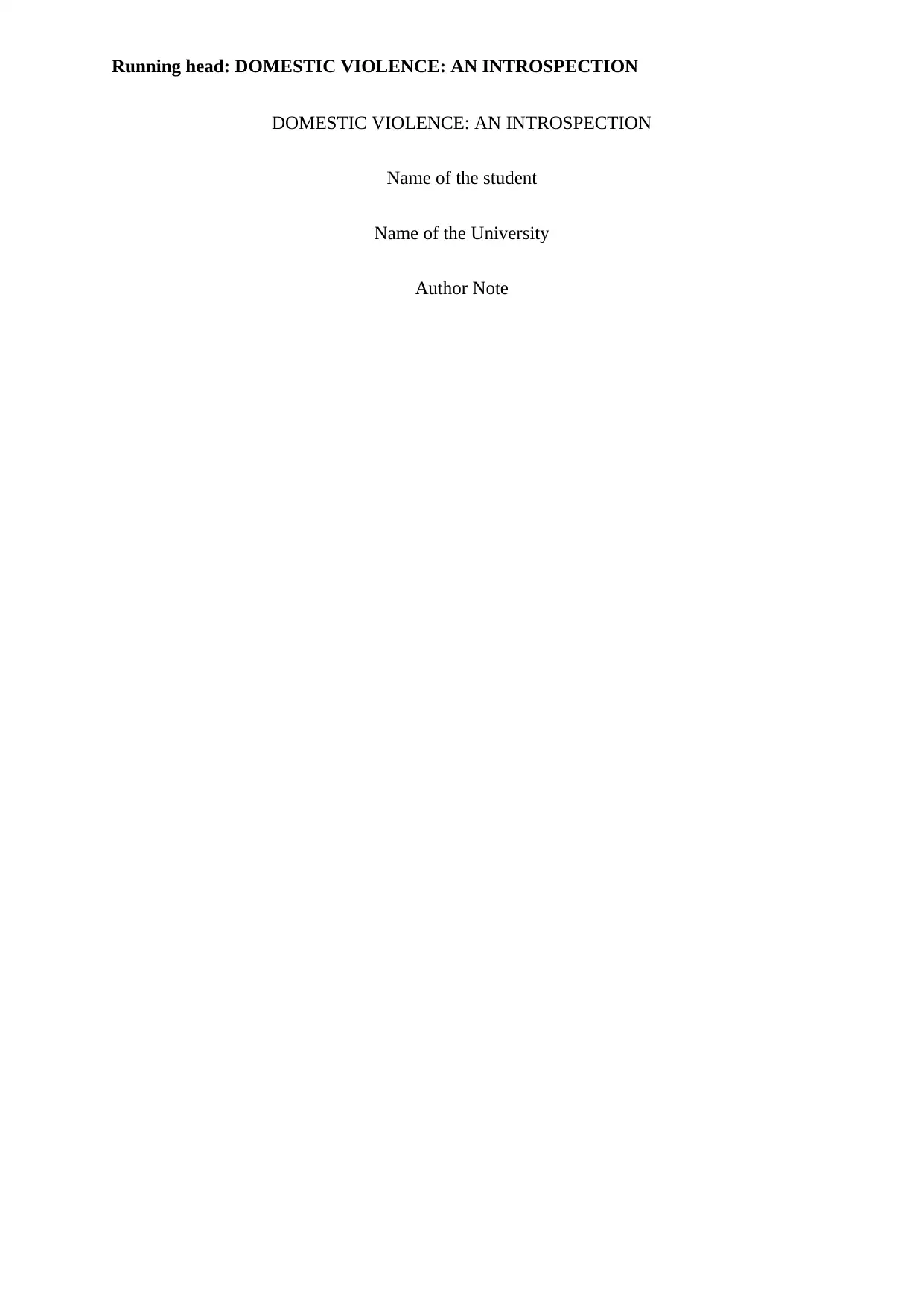
Running head: DOMESTIC VIOLENCE: AN INTROSPECTION
DOMESTIC VIOLENCE: AN INTROSPECTION
Name of the student
Name of the University
Author Note
DOMESTIC VIOLENCE: AN INTROSPECTION
Name of the student
Name of the University
Author Note
Paraphrase This Document
Need a fresh take? Get an instant paraphrase of this document with our AI Paraphraser
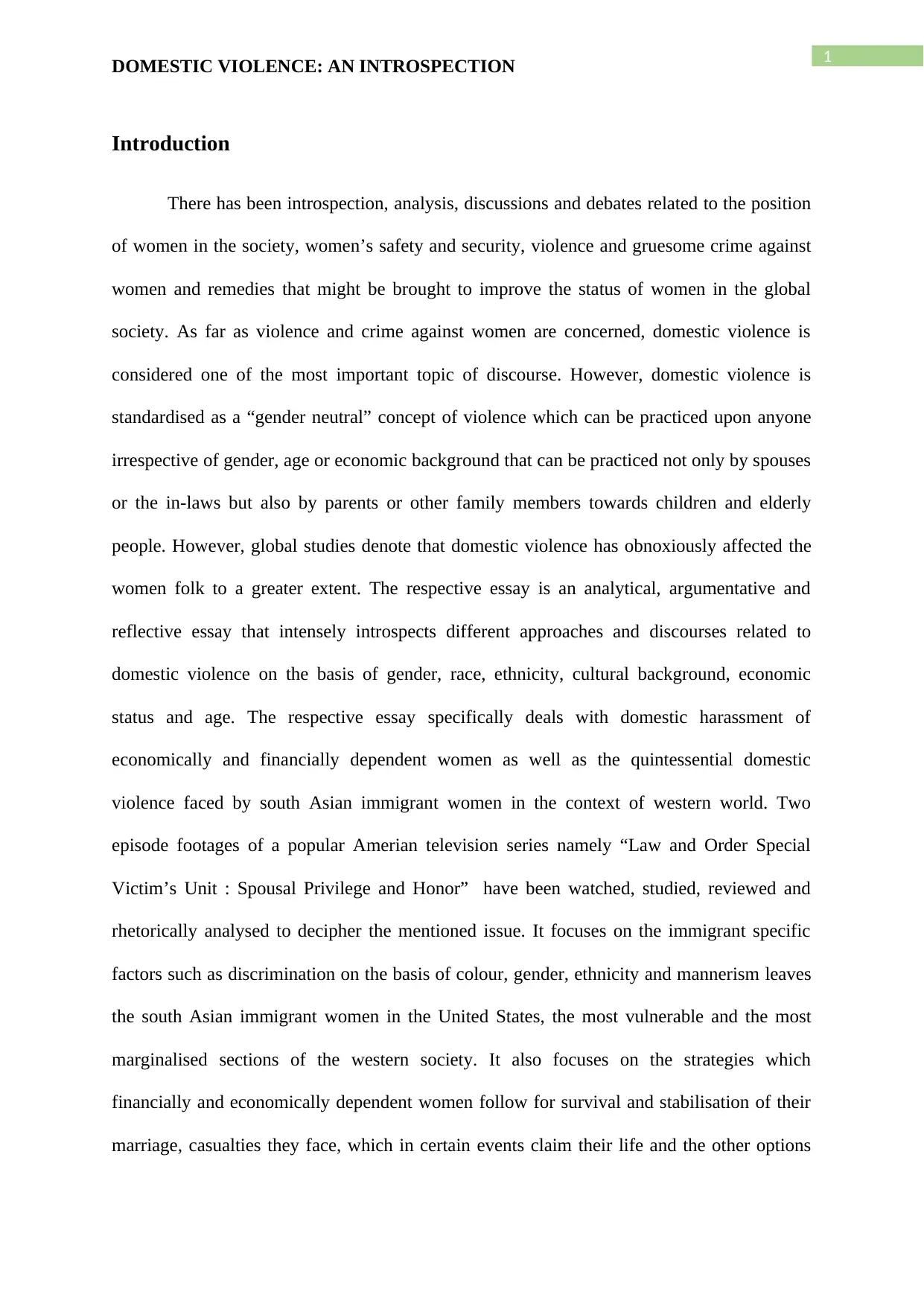
1
DOMESTIC VIOLENCE: AN INTROSPECTION
Introduction
There has been introspection, analysis, discussions and debates related to the position
of women in the society, women’s safety and security, violence and gruesome crime against
women and remedies that might be brought to improve the status of women in the global
society. As far as violence and crime against women are concerned, domestic violence is
considered one of the most important topic of discourse. However, domestic violence is
standardised as a “gender neutral” concept of violence which can be practiced upon anyone
irrespective of gender, age or economic background that can be practiced not only by spouses
or the in-laws but also by parents or other family members towards children and elderly
people. However, global studies denote that domestic violence has obnoxiously affected the
women folk to a greater extent. The respective essay is an analytical, argumentative and
reflective essay that intensely introspects different approaches and discourses related to
domestic violence on the basis of gender, race, ethnicity, cultural background, economic
status and age. The respective essay specifically deals with domestic harassment of
economically and financially dependent women as well as the quintessential domestic
violence faced by south Asian immigrant women in the context of western world. Two
episode footages of a popular Amerian television series namely “Law and Order Special
Victim’s Unit : Spousal Privilege and Honor” have been watched, studied, reviewed and
rhetorically analysed to decipher the mentioned issue. It focuses on the immigrant specific
factors such as discrimination on the basis of colour, gender, ethnicity and mannerism leaves
the south Asian immigrant women in the United States, the most vulnerable and the most
marginalised sections of the western society. It also focuses on the strategies which
financially and economically dependent women follow for survival and stabilisation of their
marriage, casualties they face, which in certain events claim their life and the other options
DOMESTIC VIOLENCE: AN INTROSPECTION
Introduction
There has been introspection, analysis, discussions and debates related to the position
of women in the society, women’s safety and security, violence and gruesome crime against
women and remedies that might be brought to improve the status of women in the global
society. As far as violence and crime against women are concerned, domestic violence is
considered one of the most important topic of discourse. However, domestic violence is
standardised as a “gender neutral” concept of violence which can be practiced upon anyone
irrespective of gender, age or economic background that can be practiced not only by spouses
or the in-laws but also by parents or other family members towards children and elderly
people. However, global studies denote that domestic violence has obnoxiously affected the
women folk to a greater extent. The respective essay is an analytical, argumentative and
reflective essay that intensely introspects different approaches and discourses related to
domestic violence on the basis of gender, race, ethnicity, cultural background, economic
status and age. The respective essay specifically deals with domestic harassment of
economically and financially dependent women as well as the quintessential domestic
violence faced by south Asian immigrant women in the context of western world. Two
episode footages of a popular Amerian television series namely “Law and Order Special
Victim’s Unit : Spousal Privilege and Honor” have been watched, studied, reviewed and
rhetorically analysed to decipher the mentioned issue. It focuses on the immigrant specific
factors such as discrimination on the basis of colour, gender, ethnicity and mannerism leaves
the south Asian immigrant women in the United States, the most vulnerable and the most
marginalised sections of the western society. It also focuses on the strategies which
financially and economically dependent women follow for survival and stabilisation of their
marriage, casualties they face, which in certain events claim their life and the other options
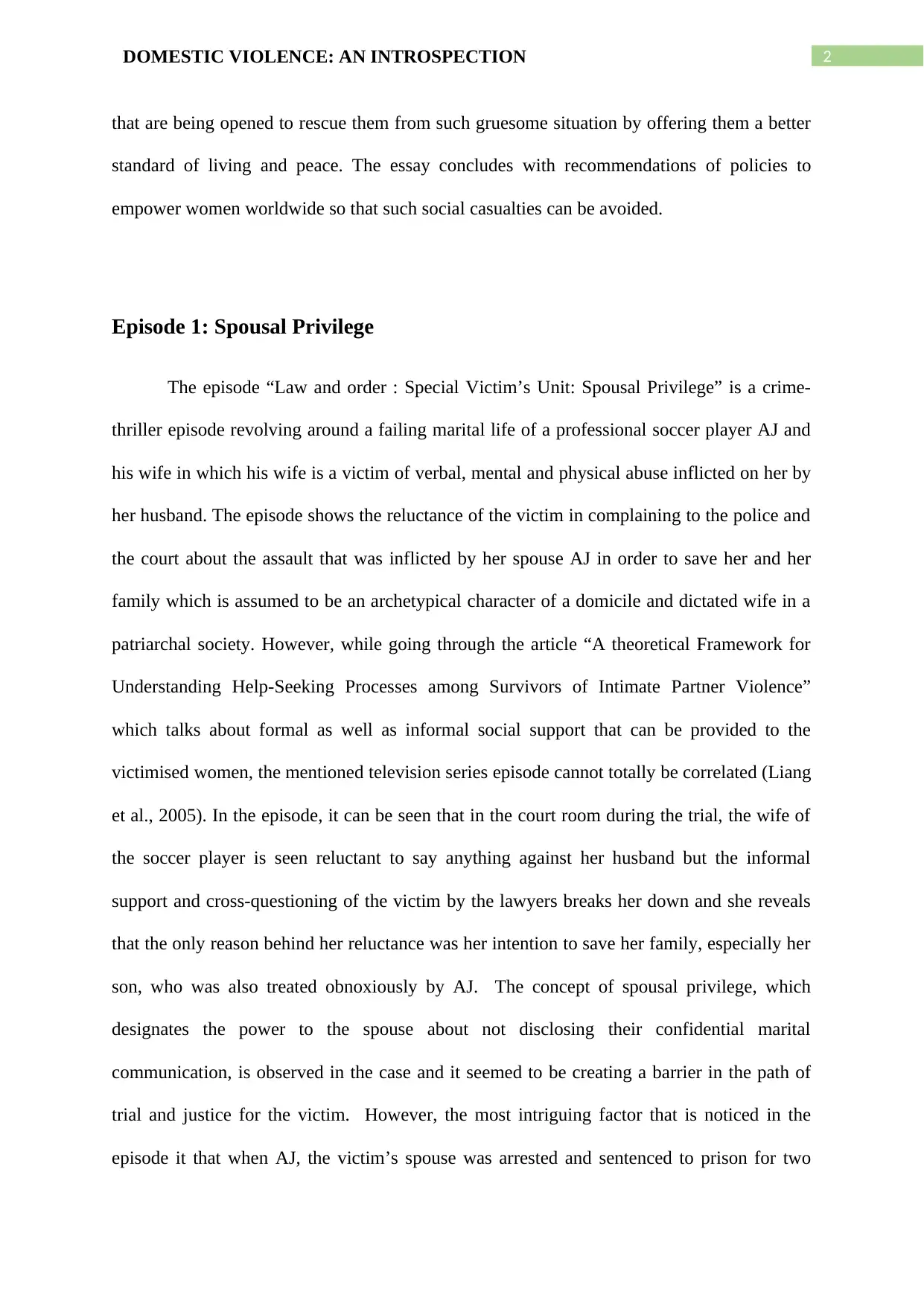
2DOMESTIC VIOLENCE: AN INTROSPECTION
that are being opened to rescue them from such gruesome situation by offering them a better
standard of living and peace. The essay concludes with recommendations of policies to
empower women worldwide so that such social casualties can be avoided.
Episode 1: Spousal Privilege
The episode “Law and order : Special Victim’s Unit: Spousal Privilege” is a crime-
thriller episode revolving around a failing marital life of a professional soccer player AJ and
his wife in which his wife is a victim of verbal, mental and physical abuse inflicted on her by
her husband. The episode shows the reluctance of the victim in complaining to the police and
the court about the assault that was inflicted by her spouse AJ in order to save her and her
family which is assumed to be an archetypical character of a domicile and dictated wife in a
patriarchal society. However, while going through the article “A theoretical Framework for
Understanding Help-Seeking Processes among Survivors of Intimate Partner Violence”
which talks about formal as well as informal social support that can be provided to the
victimised women, the mentioned television series episode cannot totally be correlated (Liang
et al., 2005). In the episode, it can be seen that in the court room during the trial, the wife of
the soccer player is seen reluctant to say anything against her husband but the informal
support and cross-questioning of the victim by the lawyers breaks her down and she reveals
that the only reason behind her reluctance was her intention to save her family, especially her
son, who was also treated obnoxiously by AJ. The concept of spousal privilege, which
designates the power to the spouse about not disclosing their confidential marital
communication, is observed in the case and it seemed to be creating a barrier in the path of
trial and justice for the victim. However, the most intriguing factor that is noticed in the
episode it that when AJ, the victim’s spouse was arrested and sentenced to prison for two
that are being opened to rescue them from such gruesome situation by offering them a better
standard of living and peace. The essay concludes with recommendations of policies to
empower women worldwide so that such social casualties can be avoided.
Episode 1: Spousal Privilege
The episode “Law and order : Special Victim’s Unit: Spousal Privilege” is a crime-
thriller episode revolving around a failing marital life of a professional soccer player AJ and
his wife in which his wife is a victim of verbal, mental and physical abuse inflicted on her by
her husband. The episode shows the reluctance of the victim in complaining to the police and
the court about the assault that was inflicted by her spouse AJ in order to save her and her
family which is assumed to be an archetypical character of a domicile and dictated wife in a
patriarchal society. However, while going through the article “A theoretical Framework for
Understanding Help-Seeking Processes among Survivors of Intimate Partner Violence”
which talks about formal as well as informal social support that can be provided to the
victimised women, the mentioned television series episode cannot totally be correlated (Liang
et al., 2005). In the episode, it can be seen that in the court room during the trial, the wife of
the soccer player is seen reluctant to say anything against her husband but the informal
support and cross-questioning of the victim by the lawyers breaks her down and she reveals
that the only reason behind her reluctance was her intention to save her family, especially her
son, who was also treated obnoxiously by AJ. The concept of spousal privilege, which
designates the power to the spouse about not disclosing their confidential marital
communication, is observed in the case and it seemed to be creating a barrier in the path of
trial and justice for the victim. However, the most intriguing factor that is noticed in the
episode it that when AJ, the victim’s spouse was arrested and sentenced to prison for two
⊘ This is a preview!⊘
Do you want full access?
Subscribe today to unlock all pages.

Trusted by 1+ million students worldwide
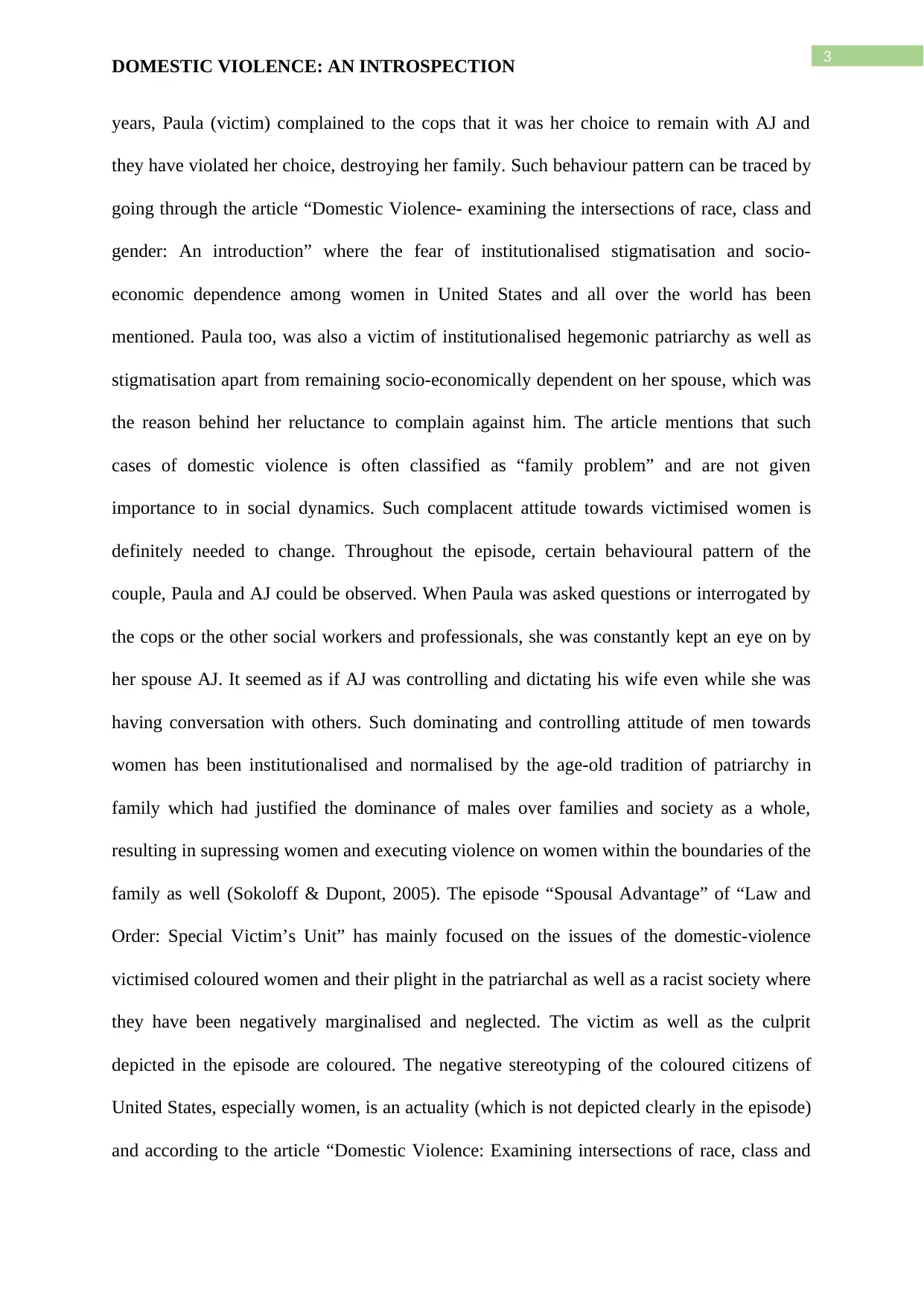
3
DOMESTIC VIOLENCE: AN INTROSPECTION
years, Paula (victim) complained to the cops that it was her choice to remain with AJ and
they have violated her choice, destroying her family. Such behaviour pattern can be traced by
going through the article “Domestic Violence- examining the intersections of race, class and
gender: An introduction” where the fear of institutionalised stigmatisation and socio-
economic dependence among women in United States and all over the world has been
mentioned. Paula too, was also a victim of institutionalised hegemonic patriarchy as well as
stigmatisation apart from remaining socio-economically dependent on her spouse, which was
the reason behind her reluctance to complain against him. The article mentions that such
cases of domestic violence is often classified as “family problem” and are not given
importance to in social dynamics. Such complacent attitude towards victimised women is
definitely needed to change. Throughout the episode, certain behavioural pattern of the
couple, Paula and AJ could be observed. When Paula was asked questions or interrogated by
the cops or the other social workers and professionals, she was constantly kept an eye on by
her spouse AJ. It seemed as if AJ was controlling and dictating his wife even while she was
having conversation with others. Such dominating and controlling attitude of men towards
women has been institutionalised and normalised by the age-old tradition of patriarchy in
family which had justified the dominance of males over families and society as a whole,
resulting in supressing women and executing violence on women within the boundaries of the
family as well (Sokoloff & Dupont, 2005). The episode “Spousal Advantage” of “Law and
Order: Special Victim’s Unit” has mainly focused on the issues of the domestic-violence
victimised coloured women and their plight in the patriarchal as well as a racist society where
they have been negatively marginalised and neglected. The victim as well as the culprit
depicted in the episode are coloured. The negative stereotyping of the coloured citizens of
United States, especially women, is an actuality (which is not depicted clearly in the episode)
and according to the article “Domestic Violence: Examining intersections of race, class and
DOMESTIC VIOLENCE: AN INTROSPECTION
years, Paula (victim) complained to the cops that it was her choice to remain with AJ and
they have violated her choice, destroying her family. Such behaviour pattern can be traced by
going through the article “Domestic Violence- examining the intersections of race, class and
gender: An introduction” where the fear of institutionalised stigmatisation and socio-
economic dependence among women in United States and all over the world has been
mentioned. Paula too, was also a victim of institutionalised hegemonic patriarchy as well as
stigmatisation apart from remaining socio-economically dependent on her spouse, which was
the reason behind her reluctance to complain against him. The article mentions that such
cases of domestic violence is often classified as “family problem” and are not given
importance to in social dynamics. Such complacent attitude towards victimised women is
definitely needed to change. Throughout the episode, certain behavioural pattern of the
couple, Paula and AJ could be observed. When Paula was asked questions or interrogated by
the cops or the other social workers and professionals, she was constantly kept an eye on by
her spouse AJ. It seemed as if AJ was controlling and dictating his wife even while she was
having conversation with others. Such dominating and controlling attitude of men towards
women has been institutionalised and normalised by the age-old tradition of patriarchy in
family which had justified the dominance of males over families and society as a whole,
resulting in supressing women and executing violence on women within the boundaries of the
family as well (Sokoloff & Dupont, 2005). The episode “Spousal Advantage” of “Law and
Order: Special Victim’s Unit” has mainly focused on the issues of the domestic-violence
victimised coloured women and their plight in the patriarchal as well as a racist society where
they have been negatively marginalised and neglected. The victim as well as the culprit
depicted in the episode are coloured. The negative stereotyping of the coloured citizens of
United States, especially women, is an actuality (which is not depicted clearly in the episode)
and according to the article “Domestic Violence: Examining intersections of race, class and
Paraphrase This Document
Need a fresh take? Get an instant paraphrase of this document with our AI Paraphraser
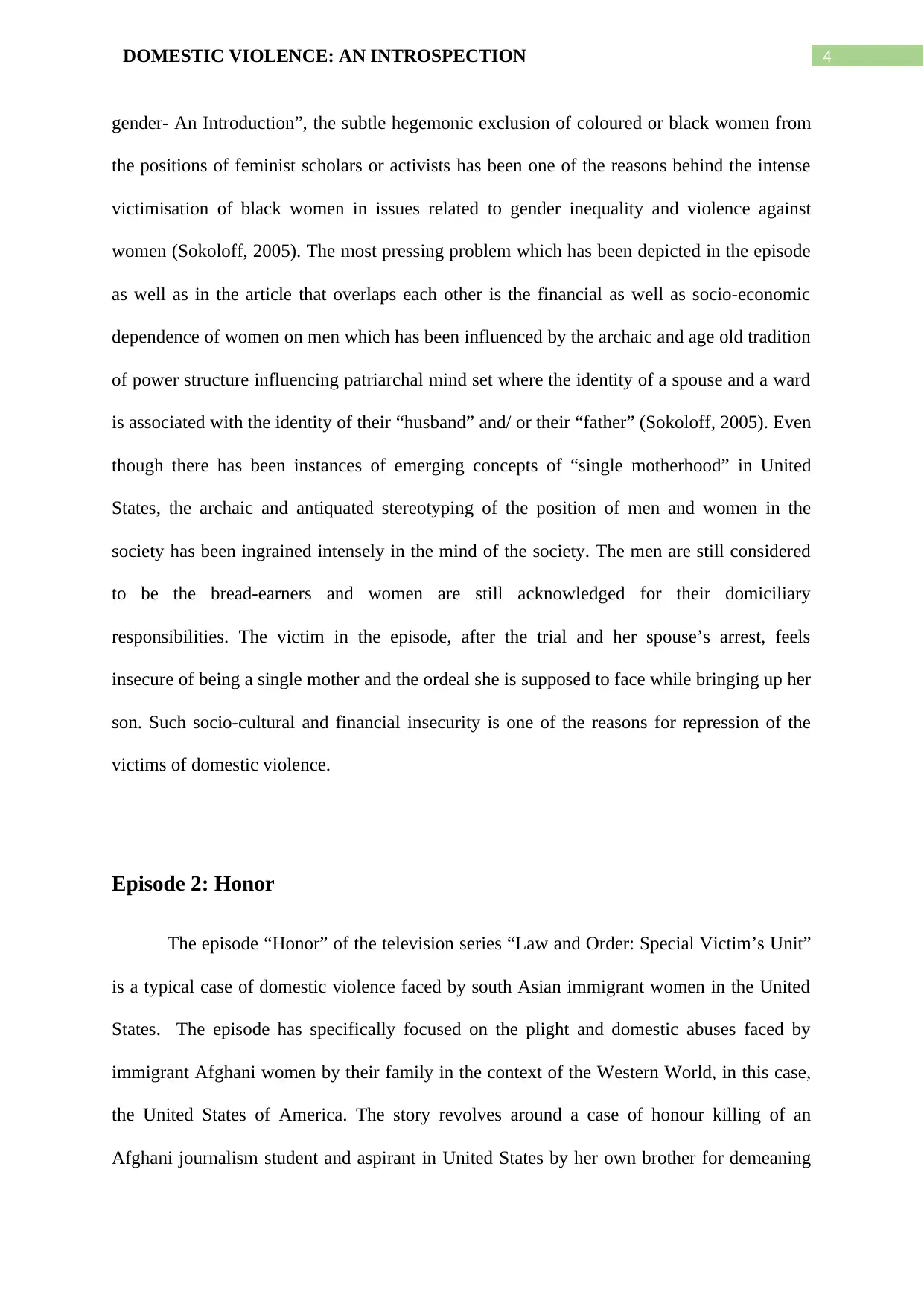
4DOMESTIC VIOLENCE: AN INTROSPECTION
gender- An Introduction”, the subtle hegemonic exclusion of coloured or black women from
the positions of feminist scholars or activists has been one of the reasons behind the intense
victimisation of black women in issues related to gender inequality and violence against
women (Sokoloff, 2005). The most pressing problem which has been depicted in the episode
as well as in the article that overlaps each other is the financial as well as socio-economic
dependence of women on men which has been influenced by the archaic and age old tradition
of power structure influencing patriarchal mind set where the identity of a spouse and a ward
is associated with the identity of their “husband” and/ or their “father” (Sokoloff, 2005). Even
though there has been instances of emerging concepts of “single motherhood” in United
States, the archaic and antiquated stereotyping of the position of men and women in the
society has been ingrained intensely in the mind of the society. The men are still considered
to be the bread-earners and women are still acknowledged for their domiciliary
responsibilities. The victim in the episode, after the trial and her spouse’s arrest, feels
insecure of being a single mother and the ordeal she is supposed to face while bringing up her
son. Such socio-cultural and financial insecurity is one of the reasons for repression of the
victims of domestic violence.
Episode 2: Honor
The episode “Honor” of the television series “Law and Order: Special Victim’s Unit”
is a typical case of domestic violence faced by south Asian immigrant women in the United
States. The episode has specifically focused on the plight and domestic abuses faced by
immigrant Afghani women by their family in the context of the Western World, in this case,
the United States of America. The story revolves around a case of honour killing of an
Afghani journalism student and aspirant in United States by her own brother for demeaning
gender- An Introduction”, the subtle hegemonic exclusion of coloured or black women from
the positions of feminist scholars or activists has been one of the reasons behind the intense
victimisation of black women in issues related to gender inequality and violence against
women (Sokoloff, 2005). The most pressing problem which has been depicted in the episode
as well as in the article that overlaps each other is the financial as well as socio-economic
dependence of women on men which has been influenced by the archaic and age old tradition
of power structure influencing patriarchal mind set where the identity of a spouse and a ward
is associated with the identity of their “husband” and/ or their “father” (Sokoloff, 2005). Even
though there has been instances of emerging concepts of “single motherhood” in United
States, the archaic and antiquated stereotyping of the position of men and women in the
society has been ingrained intensely in the mind of the society. The men are still considered
to be the bread-earners and women are still acknowledged for their domiciliary
responsibilities. The victim in the episode, after the trial and her spouse’s arrest, feels
insecure of being a single mother and the ordeal she is supposed to face while bringing up her
son. Such socio-cultural and financial insecurity is one of the reasons for repression of the
victims of domestic violence.
Episode 2: Honor
The episode “Honor” of the television series “Law and Order: Special Victim’s Unit”
is a typical case of domestic violence faced by south Asian immigrant women in the United
States. The episode has specifically focused on the plight and domestic abuses faced by
immigrant Afghani women by their family in the context of the Western World, in this case,
the United States of America. The story revolves around a case of honour killing of an
Afghani journalism student and aspirant in United States by her own brother for demeaning
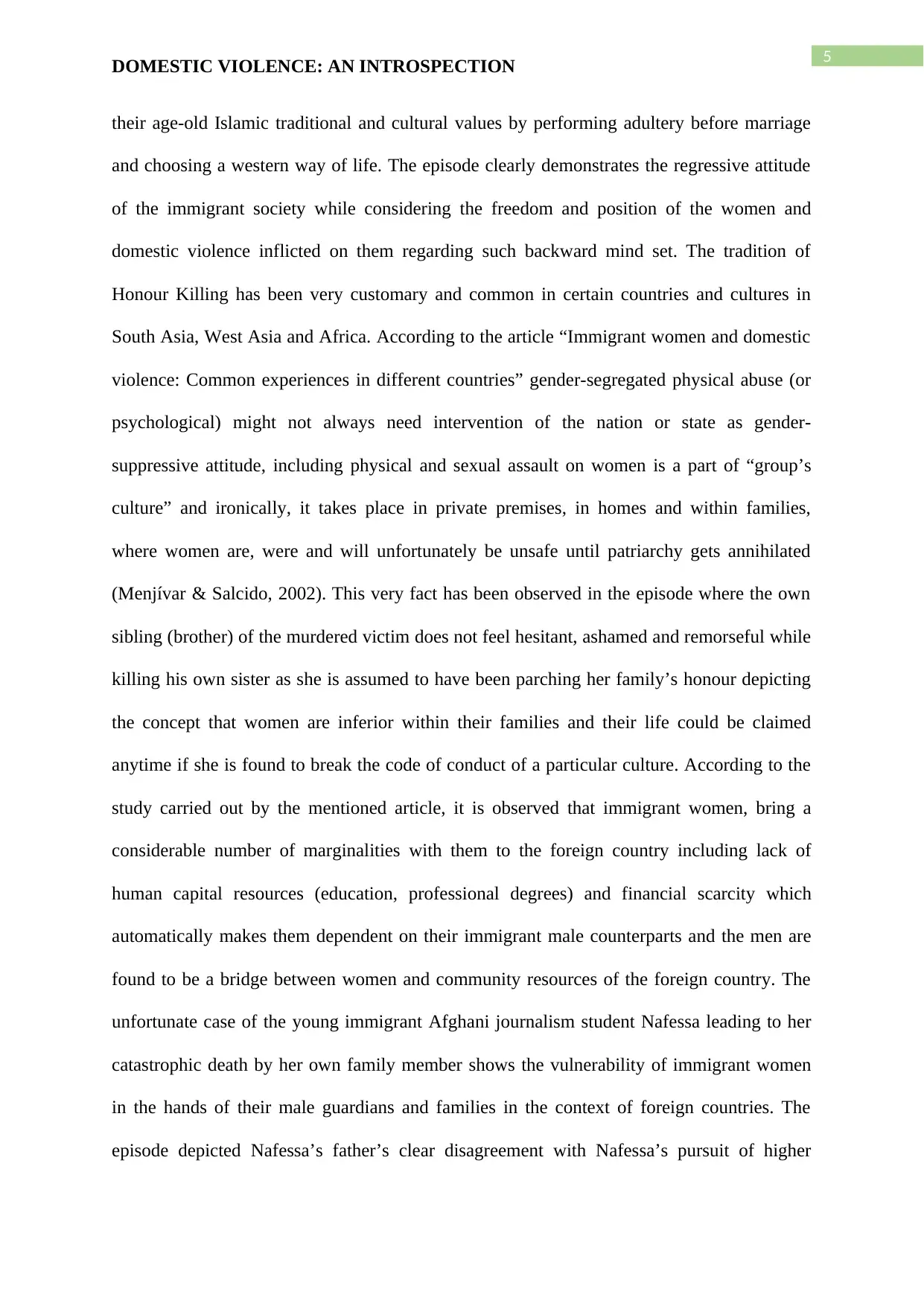
5
DOMESTIC VIOLENCE: AN INTROSPECTION
their age-old Islamic traditional and cultural values by performing adultery before marriage
and choosing a western way of life. The episode clearly demonstrates the regressive attitude
of the immigrant society while considering the freedom and position of the women and
domestic violence inflicted on them regarding such backward mind set. The tradition of
Honour Killing has been very customary and common in certain countries and cultures in
South Asia, West Asia and Africa. According to the article “Immigrant women and domestic
violence: Common experiences in different countries” gender-segregated physical abuse (or
psychological) might not always need intervention of the nation or state as gender-
suppressive attitude, including physical and sexual assault on women is a part of “group’s
culture” and ironically, it takes place in private premises, in homes and within families,
where women are, were and will unfortunately be unsafe until patriarchy gets annihilated
(Menjívar & Salcido, 2002). This very fact has been observed in the episode where the own
sibling (brother) of the murdered victim does not feel hesitant, ashamed and remorseful while
killing his own sister as she is assumed to have been parching her family’s honour depicting
the concept that women are inferior within their families and their life could be claimed
anytime if she is found to break the code of conduct of a particular culture. According to the
study carried out by the mentioned article, it is observed that immigrant women, bring a
considerable number of marginalities with them to the foreign country including lack of
human capital resources (education, professional degrees) and financial scarcity which
automatically makes them dependent on their immigrant male counterparts and the men are
found to be a bridge between women and community resources of the foreign country. The
unfortunate case of the young immigrant Afghani journalism student Nafessa leading to her
catastrophic death by her own family member shows the vulnerability of immigrant women
in the hands of their male guardians and families in the context of foreign countries. The
episode depicted Nafessa’s father’s clear disagreement with Nafessa’s pursuit of higher
DOMESTIC VIOLENCE: AN INTROSPECTION
their age-old Islamic traditional and cultural values by performing adultery before marriage
and choosing a western way of life. The episode clearly demonstrates the regressive attitude
of the immigrant society while considering the freedom and position of the women and
domestic violence inflicted on them regarding such backward mind set. The tradition of
Honour Killing has been very customary and common in certain countries and cultures in
South Asia, West Asia and Africa. According to the article “Immigrant women and domestic
violence: Common experiences in different countries” gender-segregated physical abuse (or
psychological) might not always need intervention of the nation or state as gender-
suppressive attitude, including physical and sexual assault on women is a part of “group’s
culture” and ironically, it takes place in private premises, in homes and within families,
where women are, were and will unfortunately be unsafe until patriarchy gets annihilated
(Menjívar & Salcido, 2002). This very fact has been observed in the episode where the own
sibling (brother) of the murdered victim does not feel hesitant, ashamed and remorseful while
killing his own sister as she is assumed to have been parching her family’s honour depicting
the concept that women are inferior within their families and their life could be claimed
anytime if she is found to break the code of conduct of a particular culture. According to the
study carried out by the mentioned article, it is observed that immigrant women, bring a
considerable number of marginalities with them to the foreign country including lack of
human capital resources (education, professional degrees) and financial scarcity which
automatically makes them dependent on their immigrant male counterparts and the men are
found to be a bridge between women and community resources of the foreign country. The
unfortunate case of the young immigrant Afghani journalism student Nafessa leading to her
catastrophic death by her own family member shows the vulnerability of immigrant women
in the hands of their male guardians and families in the context of foreign countries. The
episode depicted Nafessa’s father’s clear disagreement with Nafessa’s pursuit of higher
⊘ This is a preview!⊘
Do you want full access?
Subscribe today to unlock all pages.

Trusted by 1+ million students worldwide
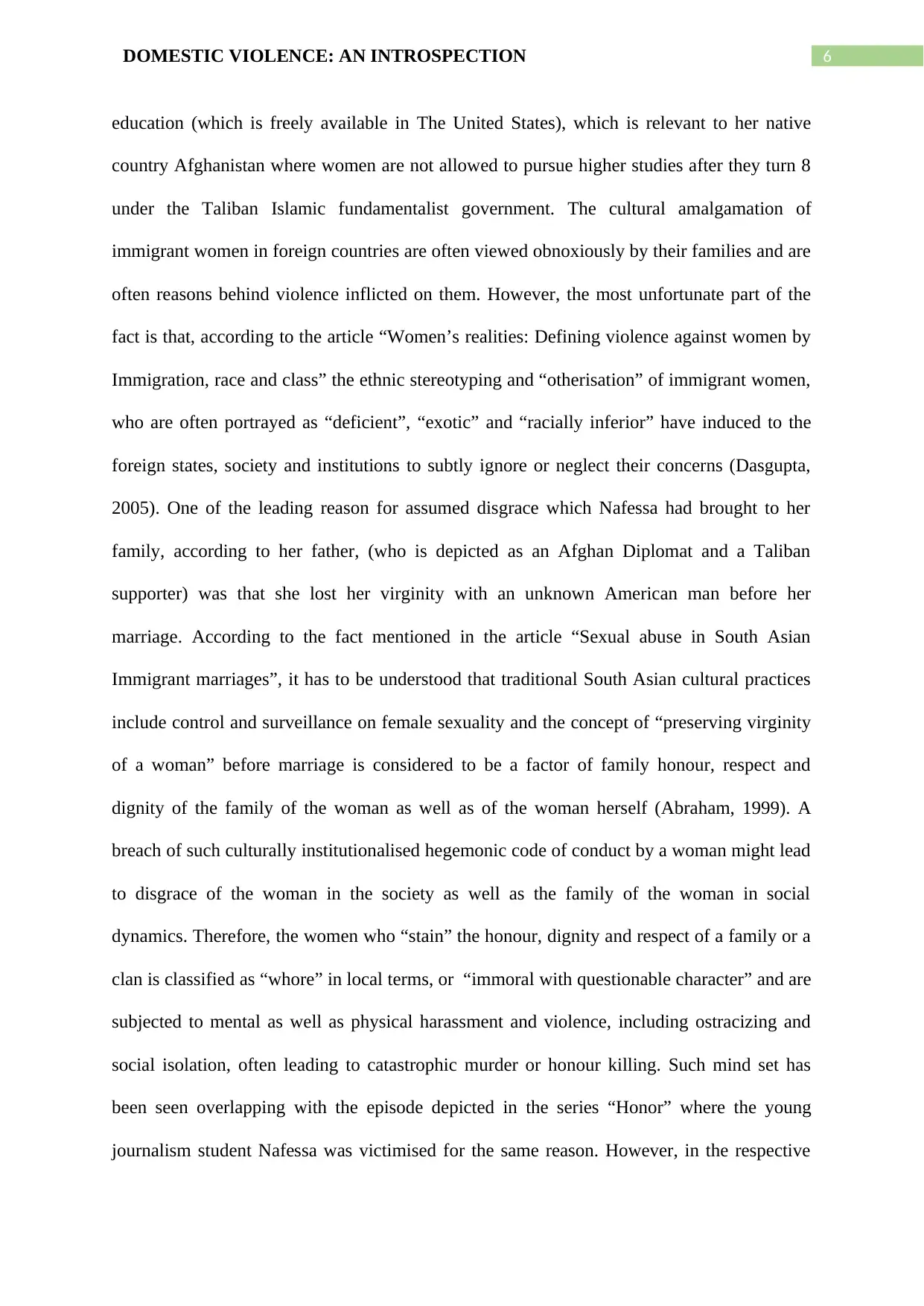
6DOMESTIC VIOLENCE: AN INTROSPECTION
education (which is freely available in The United States), which is relevant to her native
country Afghanistan where women are not allowed to pursue higher studies after they turn 8
under the Taliban Islamic fundamentalist government. The cultural amalgamation of
immigrant women in foreign countries are often viewed obnoxiously by their families and are
often reasons behind violence inflicted on them. However, the most unfortunate part of the
fact is that, according to the article “Women’s realities: Defining violence against women by
Immigration, race and class” the ethnic stereotyping and “otherisation” of immigrant women,
who are often portrayed as “deficient”, “exotic” and “racially inferior” have induced to the
foreign states, society and institutions to subtly ignore or neglect their concerns (Dasgupta,
2005). One of the leading reason for assumed disgrace which Nafessa had brought to her
family, according to her father, (who is depicted as an Afghan Diplomat and a Taliban
supporter) was that she lost her virginity with an unknown American man before her
marriage. According to the fact mentioned in the article “Sexual abuse in South Asian
Immigrant marriages”, it has to be understood that traditional South Asian cultural practices
include control and surveillance on female sexuality and the concept of “preserving virginity
of a woman” before marriage is considered to be a factor of family honour, respect and
dignity of the family of the woman as well as of the woman herself (Abraham, 1999). A
breach of such culturally institutionalised hegemonic code of conduct by a woman might lead
to disgrace of the woman in the society as well as the family of the woman in social
dynamics. Therefore, the women who “stain” the honour, dignity and respect of a family or a
clan is classified as “whore” in local terms, or “immoral with questionable character” and are
subjected to mental as well as physical harassment and violence, including ostracizing and
social isolation, often leading to catastrophic murder or honour killing. Such mind set has
been seen overlapping with the episode depicted in the series “Honor” where the young
journalism student Nafessa was victimised for the same reason. However, in the respective
education (which is freely available in The United States), which is relevant to her native
country Afghanistan where women are not allowed to pursue higher studies after they turn 8
under the Taliban Islamic fundamentalist government. The cultural amalgamation of
immigrant women in foreign countries are often viewed obnoxiously by their families and are
often reasons behind violence inflicted on them. However, the most unfortunate part of the
fact is that, according to the article “Women’s realities: Defining violence against women by
Immigration, race and class” the ethnic stereotyping and “otherisation” of immigrant women,
who are often portrayed as “deficient”, “exotic” and “racially inferior” have induced to the
foreign states, society and institutions to subtly ignore or neglect their concerns (Dasgupta,
2005). One of the leading reason for assumed disgrace which Nafessa had brought to her
family, according to her father, (who is depicted as an Afghan Diplomat and a Taliban
supporter) was that she lost her virginity with an unknown American man before her
marriage. According to the fact mentioned in the article “Sexual abuse in South Asian
Immigrant marriages”, it has to be understood that traditional South Asian cultural practices
include control and surveillance on female sexuality and the concept of “preserving virginity
of a woman” before marriage is considered to be a factor of family honour, respect and
dignity of the family of the woman as well as of the woman herself (Abraham, 1999). A
breach of such culturally institutionalised hegemonic code of conduct by a woman might lead
to disgrace of the woman in the society as well as the family of the woman in social
dynamics. Therefore, the women who “stain” the honour, dignity and respect of a family or a
clan is classified as “whore” in local terms, or “immoral with questionable character” and are
subjected to mental as well as physical harassment and violence, including ostracizing and
social isolation, often leading to catastrophic murder or honour killing. Such mind set has
been seen overlapping with the episode depicted in the series “Honor” where the young
journalism student Nafessa was victimised for the same reason. However, in the respective
Paraphrase This Document
Need a fresh take? Get an instant paraphrase of this document with our AI Paraphraser
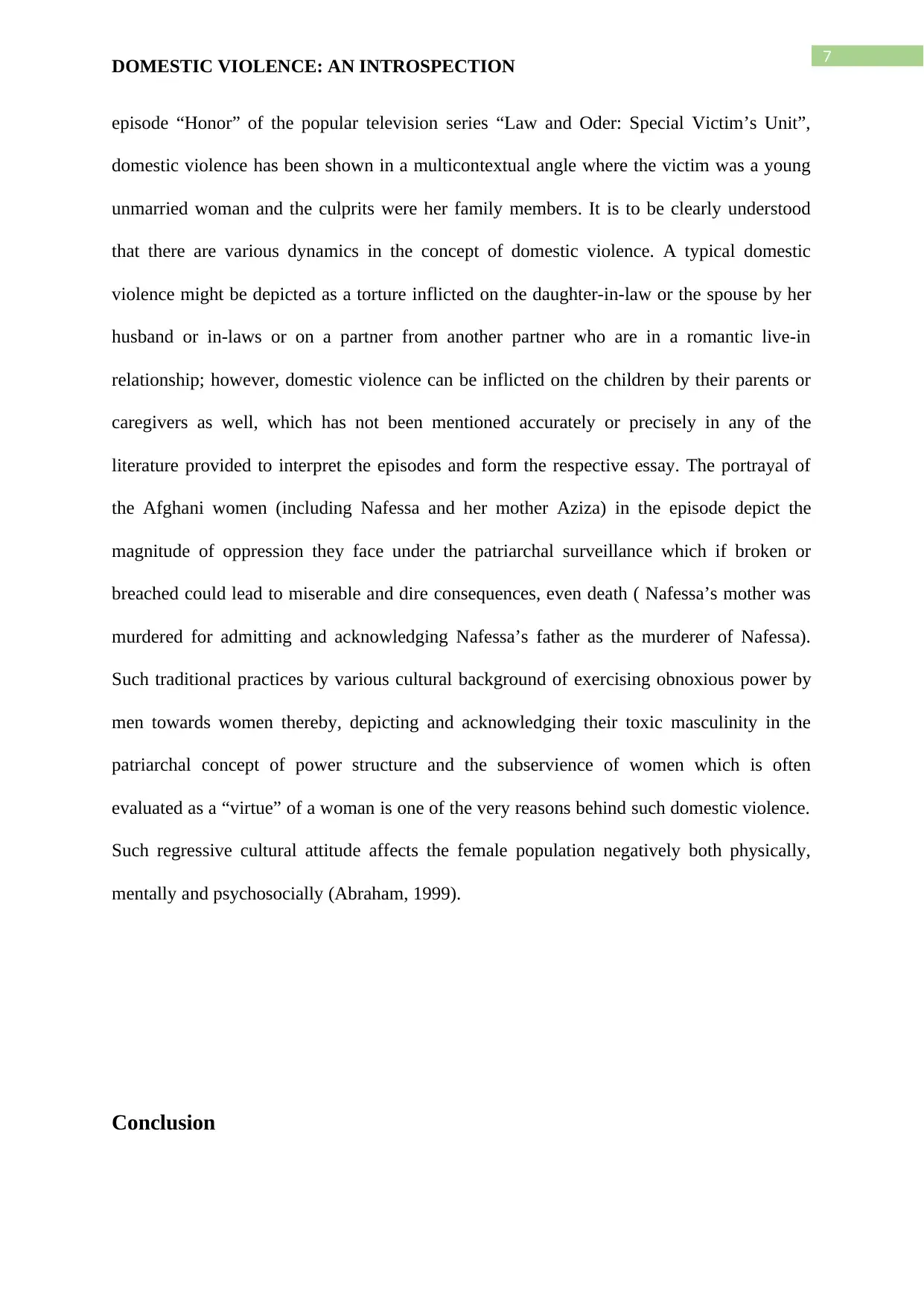
7
DOMESTIC VIOLENCE: AN INTROSPECTION
episode “Honor” of the popular television series “Law and Oder: Special Victim’s Unit”,
domestic violence has been shown in a multicontextual angle where the victim was a young
unmarried woman and the culprits were her family members. It is to be clearly understood
that there are various dynamics in the concept of domestic violence. A typical domestic
violence might be depicted as a torture inflicted on the daughter-in-law or the spouse by her
husband or in-laws or on a partner from another partner who are in a romantic live-in
relationship; however, domestic violence can be inflicted on the children by their parents or
caregivers as well, which has not been mentioned accurately or precisely in any of the
literature provided to interpret the episodes and form the respective essay. The portrayal of
the Afghani women (including Nafessa and her mother Aziza) in the episode depict the
magnitude of oppression they face under the patriarchal surveillance which if broken or
breached could lead to miserable and dire consequences, even death ( Nafessa’s mother was
murdered for admitting and acknowledging Nafessa’s father as the murderer of Nafessa).
Such traditional practices by various cultural background of exercising obnoxious power by
men towards women thereby, depicting and acknowledging their toxic masculinity in the
patriarchal concept of power structure and the subservience of women which is often
evaluated as a “virtue” of a woman is one of the very reasons behind such domestic violence.
Such regressive cultural attitude affects the female population negatively both physically,
mentally and psychosocially (Abraham, 1999).
Conclusion
DOMESTIC VIOLENCE: AN INTROSPECTION
episode “Honor” of the popular television series “Law and Oder: Special Victim’s Unit”,
domestic violence has been shown in a multicontextual angle where the victim was a young
unmarried woman and the culprits were her family members. It is to be clearly understood
that there are various dynamics in the concept of domestic violence. A typical domestic
violence might be depicted as a torture inflicted on the daughter-in-law or the spouse by her
husband or in-laws or on a partner from another partner who are in a romantic live-in
relationship; however, domestic violence can be inflicted on the children by their parents or
caregivers as well, which has not been mentioned accurately or precisely in any of the
literature provided to interpret the episodes and form the respective essay. The portrayal of
the Afghani women (including Nafessa and her mother Aziza) in the episode depict the
magnitude of oppression they face under the patriarchal surveillance which if broken or
breached could lead to miserable and dire consequences, even death ( Nafessa’s mother was
murdered for admitting and acknowledging Nafessa’s father as the murderer of Nafessa).
Such traditional practices by various cultural background of exercising obnoxious power by
men towards women thereby, depicting and acknowledging their toxic masculinity in the
patriarchal concept of power structure and the subservience of women which is often
evaluated as a “virtue” of a woman is one of the very reasons behind such domestic violence.
Such regressive cultural attitude affects the female population negatively both physically,
mentally and psychosocially (Abraham, 1999).
Conclusion
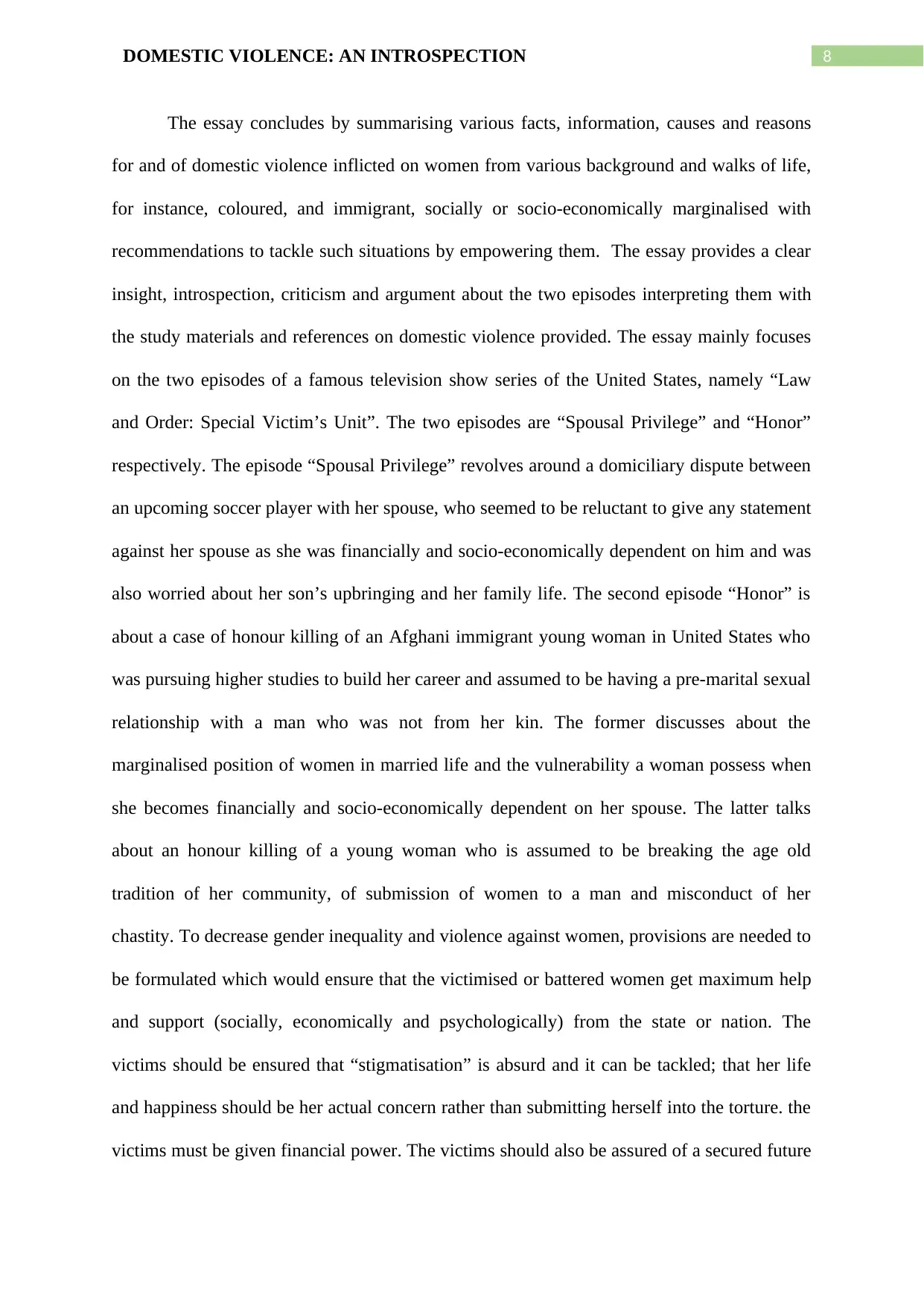
8DOMESTIC VIOLENCE: AN INTROSPECTION
The essay concludes by summarising various facts, information, causes and reasons
for and of domestic violence inflicted on women from various background and walks of life,
for instance, coloured, and immigrant, socially or socio-economically marginalised with
recommendations to tackle such situations by empowering them. The essay provides a clear
insight, introspection, criticism and argument about the two episodes interpreting them with
the study materials and references on domestic violence provided. The essay mainly focuses
on the two episodes of a famous television show series of the United States, namely “Law
and Order: Special Victim’s Unit”. The two episodes are “Spousal Privilege” and “Honor”
respectively. The episode “Spousal Privilege” revolves around a domiciliary dispute between
an upcoming soccer player with her spouse, who seemed to be reluctant to give any statement
against her spouse as she was financially and socio-economically dependent on him and was
also worried about her son’s upbringing and her family life. The second episode “Honor” is
about a case of honour killing of an Afghani immigrant young woman in United States who
was pursuing higher studies to build her career and assumed to be having a pre-marital sexual
relationship with a man who was not from her kin. The former discusses about the
marginalised position of women in married life and the vulnerability a woman possess when
she becomes financially and socio-economically dependent on her spouse. The latter talks
about an honour killing of a young woman who is assumed to be breaking the age old
tradition of her community, of submission of women to a man and misconduct of her
chastity. To decrease gender inequality and violence against women, provisions are needed to
be formulated which would ensure that the victimised or battered women get maximum help
and support (socially, economically and psychologically) from the state or nation. The
victims should be ensured that “stigmatisation” is absurd and it can be tackled; that her life
and happiness should be her actual concern rather than submitting herself into the torture. the
victims must be given financial power. The victims should also be assured of a secured future
The essay concludes by summarising various facts, information, causes and reasons
for and of domestic violence inflicted on women from various background and walks of life,
for instance, coloured, and immigrant, socially or socio-economically marginalised with
recommendations to tackle such situations by empowering them. The essay provides a clear
insight, introspection, criticism and argument about the two episodes interpreting them with
the study materials and references on domestic violence provided. The essay mainly focuses
on the two episodes of a famous television show series of the United States, namely “Law
and Order: Special Victim’s Unit”. The two episodes are “Spousal Privilege” and “Honor”
respectively. The episode “Spousal Privilege” revolves around a domiciliary dispute between
an upcoming soccer player with her spouse, who seemed to be reluctant to give any statement
against her spouse as she was financially and socio-economically dependent on him and was
also worried about her son’s upbringing and her family life. The second episode “Honor” is
about a case of honour killing of an Afghani immigrant young woman in United States who
was pursuing higher studies to build her career and assumed to be having a pre-marital sexual
relationship with a man who was not from her kin. The former discusses about the
marginalised position of women in married life and the vulnerability a woman possess when
she becomes financially and socio-economically dependent on her spouse. The latter talks
about an honour killing of a young woman who is assumed to be breaking the age old
tradition of her community, of submission of women to a man and misconduct of her
chastity. To decrease gender inequality and violence against women, provisions are needed to
be formulated which would ensure that the victimised or battered women get maximum help
and support (socially, economically and psychologically) from the state or nation. The
victims should be ensured that “stigmatisation” is absurd and it can be tackled; that her life
and happiness should be her actual concern rather than submitting herself into the torture. the
victims must be given financial power. The victims should also be assured of a secured future
⊘ This is a preview!⊘
Do you want full access?
Subscribe today to unlock all pages.

Trusted by 1+ million students worldwide

9
DOMESTIC VIOLENCE: AN INTROSPECTION
of her and her children with a proper unprejudiced process of help-seeking and support
provisions.
DOMESTIC VIOLENCE: AN INTROSPECTION
of her and her children with a proper unprejudiced process of help-seeking and support
provisions.
Paraphrase This Document
Need a fresh take? Get an instant paraphrase of this document with our AI Paraphraser
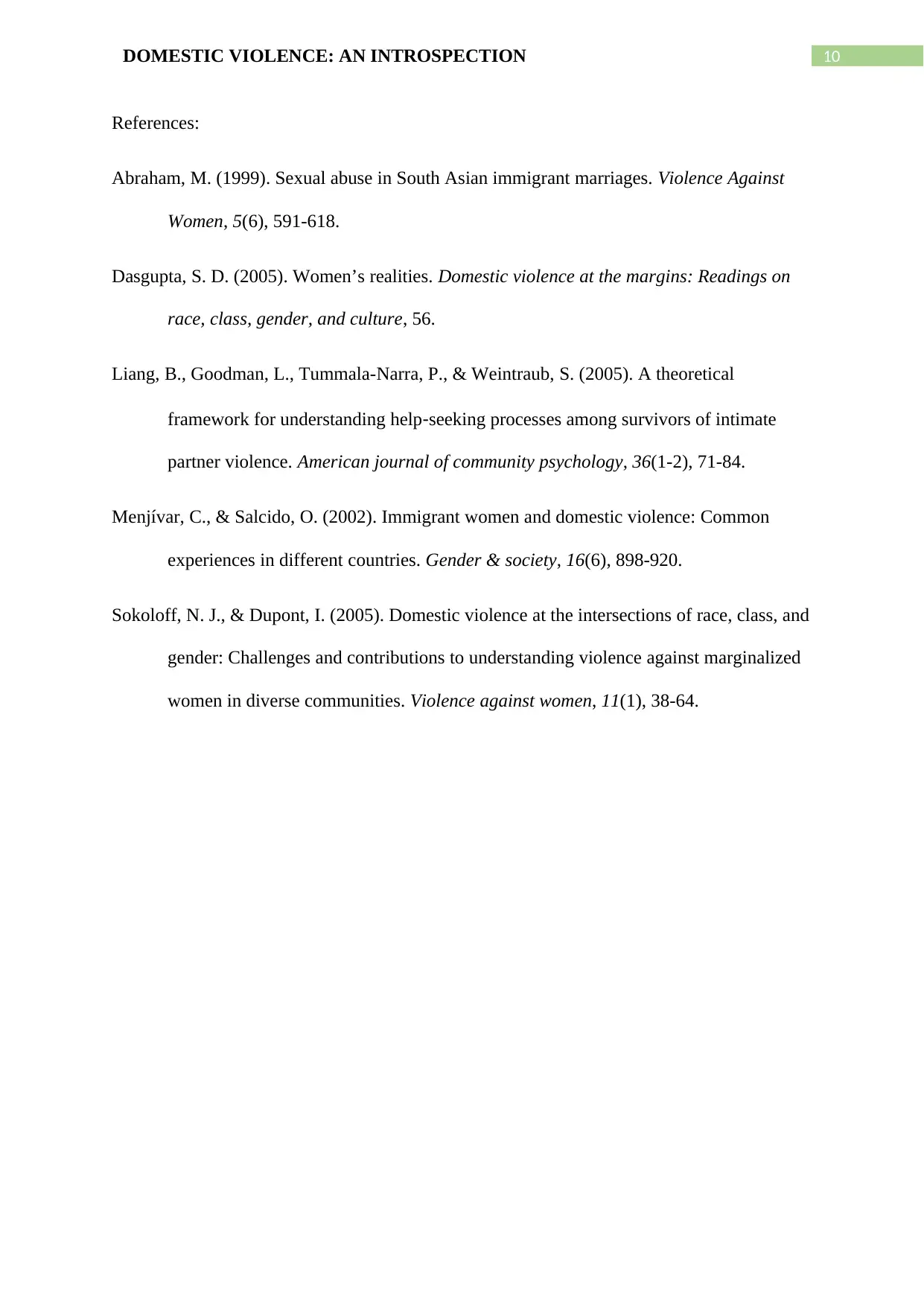
10DOMESTIC VIOLENCE: AN INTROSPECTION
References:
Abraham, M. (1999). Sexual abuse in South Asian immigrant marriages. Violence Against
Women, 5(6), 591-618.
Dasgupta, S. D. (2005). Women’s realities. Domestic violence at the margins: Readings on
race, class, gender, and culture, 56.
Liang, B., Goodman, L., Tummala-Narra, P., & Weintraub, S. (2005). A theoretical
framework for understanding help‐seeking processes among survivors of intimate
partner violence. American journal of community psychology, 36(1-2), 71-84.
Menjívar, C., & Salcido, O. (2002). Immigrant women and domestic violence: Common
experiences in different countries. Gender & society, 16(6), 898-920.
Sokoloff, N. J., & Dupont, I. (2005). Domestic violence at the intersections of race, class, and
gender: Challenges and contributions to understanding violence against marginalized
women in diverse communities. Violence against women, 11(1), 38-64.
References:
Abraham, M. (1999). Sexual abuse in South Asian immigrant marriages. Violence Against
Women, 5(6), 591-618.
Dasgupta, S. D. (2005). Women’s realities. Domestic violence at the margins: Readings on
race, class, gender, and culture, 56.
Liang, B., Goodman, L., Tummala-Narra, P., & Weintraub, S. (2005). A theoretical
framework for understanding help‐seeking processes among survivors of intimate
partner violence. American journal of community psychology, 36(1-2), 71-84.
Menjívar, C., & Salcido, O. (2002). Immigrant women and domestic violence: Common
experiences in different countries. Gender & society, 16(6), 898-920.
Sokoloff, N. J., & Dupont, I. (2005). Domestic violence at the intersections of race, class, and
gender: Challenges and contributions to understanding violence against marginalized
women in diverse communities. Violence against women, 11(1), 38-64.
1 out of 11
Your All-in-One AI-Powered Toolkit for Academic Success.
+13062052269
info@desklib.com
Available 24*7 on WhatsApp / Email
![[object Object]](/_next/static/media/star-bottom.7253800d.svg)
Unlock your academic potential
Copyright © 2020–2025 A2Z Services. All Rights Reserved. Developed and managed by ZUCOL.